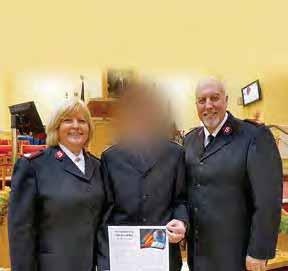
9 minute read
and 11
NOTTINGHAM WILLIAM BOOTH MEMORIAL HALLS: Ewan Domleo was enrolled as a soldier by corps officer Major Paul Johnson. Having attended the corps since birth, Ewan testified to the love, support and guidance he has received from his Army family, which has been an essential part of his life, and has helped to develop his faith and commitment to God. Ewan is pictured with Majors Julie and Paul Johnson. – J. J.
Some photos removed
BELFAST CITADEL: Libby Young was welcomed as an adherent member by corps officer Major Mark Waghorn. Libby, who is the daughter of officers, and her husband, Paul, have attended the corps regularly for several months, and she expressed the desire to make a public commitment. Referring to her recent visit to Jordan, she testified: ‘Whenever you are in God’s family and have friends and family around you, praying for you, you are supported just as I was supported while floating in the Dead Sea.’ – N. M.
HINCKLEY: Marie King testified that she was attracted to the Army after hearing a Salvationist speaker at a Good Friday Churches Together open-air meeting. Marie attended the Army the following Sunday and, having worshipped regularly at the Army ever since, has fallen in love with the style of worship. After signing her certificate at the mercy seat, Marie was welcomed as an adherent member by corps officer Major Carol Evans. Marie is a volunteer at the corps food bank. Pictured are Recruiting Sergeant Major Mavis Pascoe, Marie, Vivienne Bradley and Major Evans. – B. A.


HILLINGDON: Denise and Peter Tottman were enrolled as soldiers by corps officer Major Kevin Pitt. Both testified to a spiritual coming home as they have joined in worship and fellowship, and spoke of God’s calling upon their lives to serve him as soldiers. They are pictured with Major Christine Perkins, Val Colin and Chris Alleeson who have each played a part in their spiritual journey. – K. P.
MIDDLESBROUGH PALLISTER PARK: After hearing God tell him he should attend the Army, Stephen Collins joined the luncheon club with a friend. He then attended worship meetings and the Senior Connections programme, and felt called to become a soldier. He was enrolled by corps officer Captain Mark Anderson and says he is looking forward to telling people about Jesus. Pictured with Stephen are Captains Dawn and Mark Anderson and Corps Secretary Sheila Chandler. – M. A.

CHESTERTON: On Commitment and Vision Sunday Graham Harrison and Eileen Dean were welcomed as adherent members by corps officer Major Bryan Lang. – B. L.
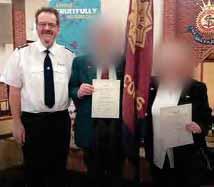

MACCLESFIELD: A Christian for many years, Alison Worrall linked up with the corps after returning from Brazil, where she worked with several church projects for a number of years. June Batty has also been a Christian for many years and started attending regularly some time ago. Her initial contact was through Bible study and Cameo, both of which she actively

participates in. Tom Dickens is the first junior soldier to be enrolled at the corps for a number of years. He was taken through preparation classes by Bernard Reece. Corps officer Major Gareth Dickens welcomed Alison and June as adherent members and enrolled Tom as a junior soldier. Geoff Wilson is also pictured holding the flag. – G. D.
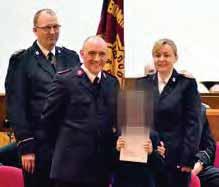

DEREHAM: Janet Crundwell and Nancy Blythe were welcomed as adherent members by corps officer Major Diana Bennetts during Adherents Sunday. Janet and Nancy testified that they feel welcome and at home at the corps and believe that this is where God wants them to serve and worship him. Also pictured is Adherents Secretary Olive Allcroft. – D. B.
BIRMINGHAM CITADEL: Oscar Hayward was enrolled as a junior soldier by corps officer Major Adrian Allman during the YP annual. They are pictured with Junior Soldiers Sergeant Ruth Taylor and YP worker Edward Dixon. Oscar gave his testimony and said he was looking forward to wearing his uniform, learning more about Jesus and joining the singing company and YP band. – R. O.
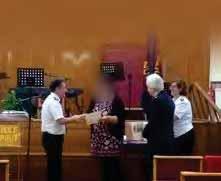
NUNHEAD: Daisy Clark decided to return to membership of the corps family and was welcomed as an adherent member by corps officer Major Polis Pantelidis. Pictured with Daisy and Polis are Commissioner Norma Swinfen and corps officer Major Maria Konti-Galinou. – P. P.

WREXHAM: Corps officers Captains Ian and Sandy Davis enrolled Glenys and Brian Prydden as soldiers. Linking up with the corps two years ago, Glenys and Brian are deeply committed Christians who want to serve Christ, and have become involved in Employment Plus, the prayer group and selling papers. – S. T.

DOES YOUR CORPS HAVE A MISSION DEVELOPMENT PLAN?
Major Ian Mountford introduces the Missional Journal
WHEN was your corps mission development plan written? What were its objectives? Experience tells me that although some will be able to answer these questions, a majority of corps members probably won’t.
So, let me ask this instead: Where is your corps on its missional journey? Is there movement? Is there evidence that God is doing something new or is the corps mainly burdened with maintenance? Or even, with deep respect, is it more like a museum or mausoleum?
In introducing the new Missional Journal I recognise that even if a corps does not have a plan, God does, and every corps is on a journey. Knowing something about that journey from the founding story to the present reality is important if we want to know where God might be leading us.
At his welcome and installation as Territorial Commander in October 2018 Commissioner Anthony Cotterill said: ‘What I am looking for, and what I believe we should all be looking for, is revelation. What is God revealing to us as The Salvation Army? And what are we going to do with that which is revealed to us by his word and by his Spirit. What is he doing... and how can we join in with him?’
These questions challenge us individually and corporately to listen to God, discern his will and engage in mission – something reaffirmed in the General’s new year message, Call to Mission.
CAPTURING THE REVELATION But how do we discern what God is saying and join in with what he is doing? Our starting point should always be Scripture and prayer. As we draw near to God to listen, we begin to understand; we capture something of his revelation. But then what?
For many years the territory has used a missional tool first introduced in the Church of England in the early 1990s. The Mission Action Plan was developed by Bishop David Hope in London as a new approach for determining mission priorities. It focused on prayer and planning but grounded these in the experiences of the people. Adopted and adapted for Salvation Army use as the Mission Development Plan (MDP) it has
been widely used with various degrees of success for many years. However, as missional theology has developed, there has been a moving on from primarily focusing on developing our plans.
The new Missional Journal, which builds on the experience of the MDP and the TIDE Strategy (Transformation, Integration, Discipleship and Effectiveness), aims to reflect these changes. It draws on the understanding that ‘Your life is a journey you must travel with a deep consciousness of God’ (1 Peter 1:18 The Message) and it seeks to give balance to all aspects of corps mission and ministry, not just the drafting of a future plan. The Missional Journal considers the overall health of the corps, mutual accountability, missional context and missional purpose, journeying one step at a time.
To understand this, it is helpful to think in terms of principles, tools and models.
Principles Our faith and practice are built on our relationship with Jesus Christ, on Scripture, on a trinitarian understanding of God, on a missional calling, on the guidance of the Holy Spirit and on our shared values.
Tools Based on these principles, missional tools are developed to help us reflect, understand and decide how we might join in the missional journey in a local context. These tools range from Bible studies and the One Army study series to tools like the Missional Journal.
Models Then, taking this understanding, we seek to model mission in practice in many different and creative ways, diverse programmes and powerful ministries.
This approach is not new; it is something that we have done in The Salvation Army since our founding.
In order to think about how we apply our faith and understand the times – the context for mission – we need to reflect, study and discern. Tools like the Missional Journal aim to help us do this, helping us to capture what is being revealed and reflect on what to do.
SIX STEPS
The Missional Journal is divided into six steps, providing an opportunity for each corps to consider how to…
1Prepare for the journey Start with Scripture and prayer
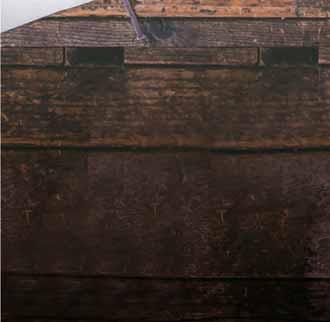
2Describe present reality Consider the transformational journey so far
3Reflect and evaluate Discern what God might be saying
4Decide and plan Consider what our reflection and evaluation means for the future
5Put the plan into action Work together to be missional

6Review together Examine mutual accountability and effectiveness Recognition is given to the fact that God speaks at any step, and such moments are important to capture in the Journal. What is God saying and how are we responding? At steps 1, 4 and 6 there is opportunity for the journey to be affirmed by DHQ – to tell the story so far, seek spiritual affirmation and celebrate the journey. Each step is also supported by a range of additional resources that will continue to be developed and added to.
Speak with your corps officer or contact your divisional mission enabler for more information about the Missional Journal.

TO CONSIDER O Where are you in your own journey with God? O Where is your corps on its missional journey? O How do you celebrate or mark the milestones of these journeys? O How might you begin to journal something of your own journey?
opportunity to consider purposefully the whole journey of a corps: its past, present and future. It aims to capture something of what God has said and done, and is saying and doing, in the life of a corps and its community. It journeys with the corps for the long haul and focuses on asking questions about experience, growth, mission and mutual accountability. It recognises other approaches, such as Natural Church Development, and gives an opportunity to work them through as part of the journey.
Importantly, the Journal records the journey step by step, without the need to rush, and ensures that corps members develop their missional life together.








